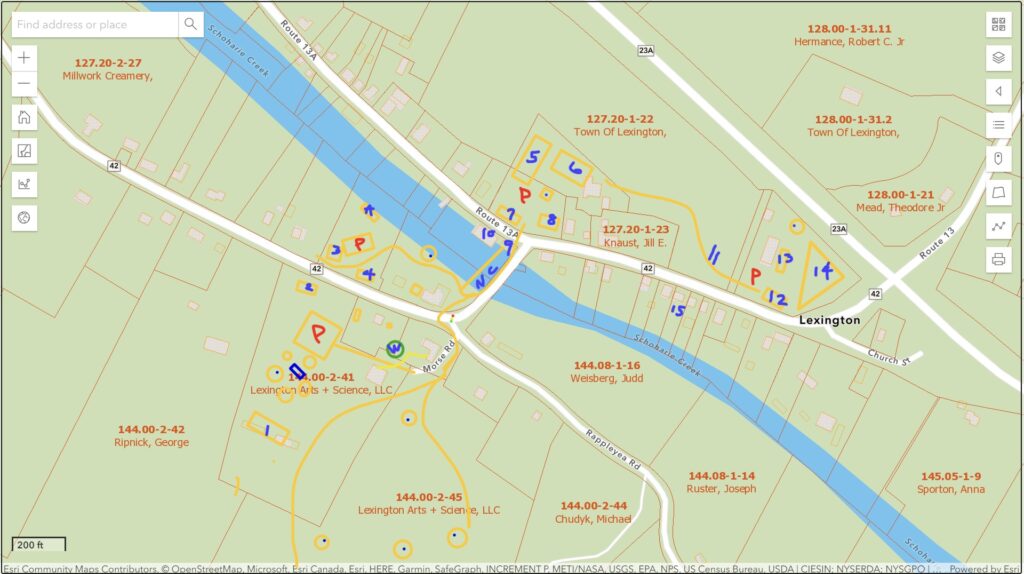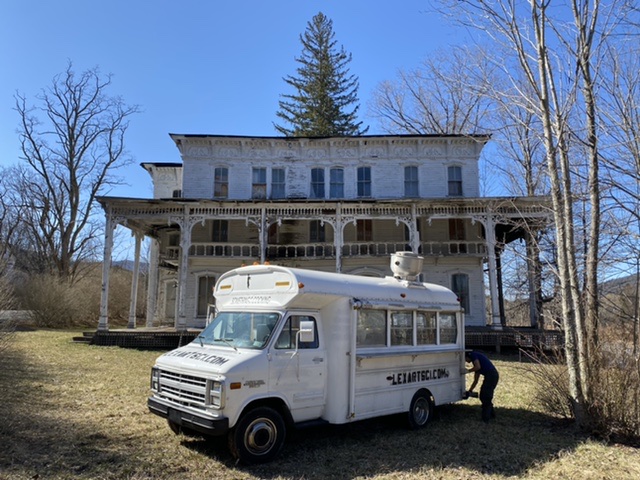Author: admin
A Vision for Lexington Hamlet

Inspired by the Lexington Hamlet Revitalization Strategy of 2018, LexArtSci achieved its goal of fostering the establishment of a general store in the hamlet. According to local sources, there were at least five general stores in Lexington in the 1950’s. Now that Van Dusen’s general store is slated to open in early 2022, we are continuing to look to the future drawing inspiration from the past.
For our Lexington hamlet, we envision a restorative community that places a high value on associational life. We envision walking paths that span the hamlet from one side to another. Along these paths are spectacular views, moments of reflection, interactions with neighbors, surprises, contact with nature. We envision a hamlet where cars passing through slow down for pedestrians; to slow down to take notice; to have a drink or to learn something; to appreciate a sound or a sight.
The paths are a mix of stone, gravel and dirt. They are hiking paths, sidewalks, singletrack, stones. They meander hrough the town, from the cemetery to the east, through the LineLand Sculpture
Lauren Engel
February 22, 2019
Behind the Scenes in New York:
Preserving a City of Historic Neighborhoods
Assignment #1: The Lexington House Hotel – History Worth Saving
Early October in the Catskills was something directly out of a Romantic era novel or a Hudson River School painting, the complete embodiment of “picturesque.” Morning fog still hugged the mountainsides as we drove the winding Route 42, which suddenly spit us out into the little town of Lexington – Greene County, New York. We were coming around a sharp bend in the road when I saw it. Large and lonely on the corner – you couldn’t miss it. To this day I cannot describe what came over me in that moment, it felt as if someone had lit my heart on fire. I could not understand how this impressive structure was left in this state of ruin, especially in the middle of the Catskills – a destination that has for centuries beckoned adventurous tourists with its delicious sense of remoteness and romance. Was I the only person who saw the potential here? I needed to know everything. I needed to do everything I could to help save this building. One problem – I had no idea how.
The Lexington House is a large three-story resort hotel in the Catskill Mountain region. The hotel was built in the Italianate style in 1883 by master carpenter Jerome Campbell to accommodate the influx of tourist to the mountainous area just northwest of New York City. With the expansion of the railroad in the late nineteenth century, the Catskills became easily accessible to tourists looking to explore the wilderness. The trek could take as much as a day from Manhattan, which meant middle-class families who ventured there often stayed a week or more, especially during the summer. The spacious hotel is an outstanding example of picturesque, late Victorian era, eclectic style architecture. It embodies the distinctive characteristics of the Italianate and Eastlake styles through its charming, slightly asymmetrical façade with a variety of decorative woodwork. A thick frieze with elaborate woodwork and a cornice embellished with modillions encircles the entire building; while segmentally arched lintels with decorative diamond-shaped keystones are noticeable above most door and window surrounds. The Lexington House also embodies characteristics commonly associated with resort architecture from this time with its broad, two-story porch encircling the front and side elevations, and many second story balconies. Although slightly deteriorated due to years of neglect, most of these decorative features survive surprisingly intact. The Lexington House was considered to be one of the finest and most popular resorts of the period, offering a broad range of entertainment and activity for guests; as is evident by the additional structures associated with the resort facility, including a former icehouse, wagon house, theater/skating rink.
The Lexington House remained a popular summer resort for many decades; until the end of the first quarter of the twentieth century, when the Catskills experienced a sharp decline in the tourist industry. During this difficult time, the Lexington House suffered great business losses; in order to avoid closing down completely, the owners changed course and re-opened the hotel as a music and arts camp. The property was later acquired by a non-profit preforming arts organization in 1973 and operated in this capacity until the early 2000’s. It appears this non-profit had made plans to restore the property and received many letters of support, but this unfortunately seems to have fallen through and the fate of the property remains uncertain. However, many townspeople continue to regard the Lexington House as the most important landmark in the community and want something good to come of it. In 2014, following the aftermath of a devastating flood, the Town of Lexington applied for and received a grant to develop a Long Term Community Recovery Strategy from the New York Department of State. During the LTCR planning process residents, businesses and other stakeholders were asked to identify issues within Lexington that they believed important to correct for the town’s long-term community recovery. One topic Lexington identified was to prioritize the preservation of historic sites, specifically the Lexington House as an important part of both the Town’s comprehensive and long-term planning. Later that same year, Lexington received a grant from the Preservation League of NYS as part of their Preserve New York Grant Program. Using a portion of this grant money the village of Lexington hired PLACE Alliance to develop strategies for revitalization in a sustainable way, and to encourage investment of commercial and residential uses. Lexington held a public brainstorming session with PLACE where participants shared suggestions of private business ventures they would like to see in town; these included an ice cream shop, brewery, general store, acclaimed restaurant and a hotel/event space. Lexington is in the heart of an important tourist area. In fact, the CREDC notes that 4 million people visit the region annually, pumping 2.1 billion dollars into the local economy. Many small business owners have capitalized on this and have established highly successful ventures in the region, including dozens of revitalized properties that are now boutique hotels/event venues (Fox Fire Mountain House, Spruceton Inn, Hillside Schoolhouse), breweries (West Kill Brewing, Rip Van Winkle Brewing Company), iconic restaurants that attract top notch chefs (Bushland Eating House), and more. Given all these successful precedents in neighboring towns it should not be difficult to attract potential business owners who are seeking opportunities in a small community like Lexington. What remains to be determined however, is the current owner of the Lexington House and if they are willing to sell or start a business. A recent update to the Lexington House’s Wikipedia page mentions the property was recently acquired in 2019, but I can find no other proof of such an acquisition. Although the Town of Lexington seems enthusiastic about the potential future of the property and the benefits it could bring to the community, the unknown identity and motive of the current owner brings uncertainty and doubt to this objective.
It would be wonderful, if this region of New York has legislature similar to NYC’s Landmarks Law – to further safeguard historical and architecturally significant buildings such as the Lexington House. If the hotel was to be considered under such a law, I firmly believe it would meet the criteria for individual landmark designation for several reasons. Firstly, the building is 137 years old, far older than the minimum 30-year requirement for consideration from the LPC. Furthermore, the Lexington House does hold special character, special historic and aesthetic value as part of the development, heritage and cultural characteristics of the Catskill Mountain Region and its tourism industry. Architecturally and stylistically, the Lexington House is a significant example of the picturesque, late Victorian era; it also embodies the distinctive characteristics of the Italianate and Eastlake styles. The hotel is distinguished by its extraordinarily high level of sophistication and fine craftsmanship, as well as its intact ornamentation. One of the last remaining examples of resort facilities in the Catskills from this era, only the Lexington House retains its integrity of design materials. The Lexington House and its resort related structures are historically valuable as they recall an important theme in the Catskills regional history and an important time in America’s tourism history. For all of these reasons, I reaffirm my belief that the LPC would and should vote in favor of designation of the Lexington House.As more and more people try and escape the bustle of urban life by taking to the woods, the Catskills offers convenient asylum just as it did centuries ago. During the late nineteenth century the Lexington House hosted hundreds, if not thousands of summer visitors. Although the establishment itself is no longer, the building remains; and so too does the potential for a new business to revitalize this old hotel. The Lexington House is a crucial historic anchor to the Catskills community. It just needs someone who believes its eminently worthwhile to preserve an important survivor from the Victorian Era to find it.
Lexington House, Photo by Chris Protopapas, 1993.
Bibliography
Evers, Alf. The Catskills: From Wilderness to Woodstock. Garden City, New York: Doubleday & Co., 1972.
Evers, Alf. Resorts of the Catskills. New York: Saint Martin’s Press, 1979.
Holson, Laura M. “The Catskills Are Back. Again. And Again.” The New York Times. June 21, 2019.
https://www.nytimes.com/2019/06/21/travel/catskills-history.html
National Register of Historic Places, Lexington House, Lexington, Greene County, New York, #86002175
New York State Department of State. Town of Lexington, Long Term Community Recovery Strategy, 2014. New
York: GPO, 2014. https://www.lexingtonny.com/uploads/3/4/3/9/34399421/lex_ltcr_draft_v4_part_i.pdf
PLACE Alliance. Town of Lexington Hamlet Revitalization: Final Presentation, October 2018.
Preservation League of New York State. Preserve New York Grants, 2014.
https://www.preservenys.org/blog/preserve-new-york-grants-2014?rq=Lexington%20
Savage McAlester, Virginia. A Field Guide to American Houses. New York: Knopf, Borzoi Books, 2013.
Shaver, Peter D. The National Register of Historic Places in New York State. New York: Rizzoli, 1993.
Revitalization
Lexington Arts + Science seeks to help revitalize the town of Lexington into a cultural hub for the Arts + Sciences.
The mission of Lexington Arts + Science is to foster Creativity, Conservation and the Exploration of Nature Through the Arts + Science.
Something’s Cooking
Nice to see you here!
Lexington the House was built around 1883.
Betty the Shortbus was built around 1983.
Both are sturdy, proud examples of American craftsmanship. Something is cooking!
We would love to hear from you.
All the best,
lexartsci @ gmail

Credit: Pao
Coming soon
But first and foremost:
Thank you to our new neighbors and friends for the warm welcome to the community!
We look forward to contributing positively to Lexington and are excited to share time with each and every one of you as we work to begin renewing this historically important property.
We welcome your input and please reach out anytime via the contact page or at lexartsci at gmail.
Warmest regards,
Alex
Lexington Arts + Science
